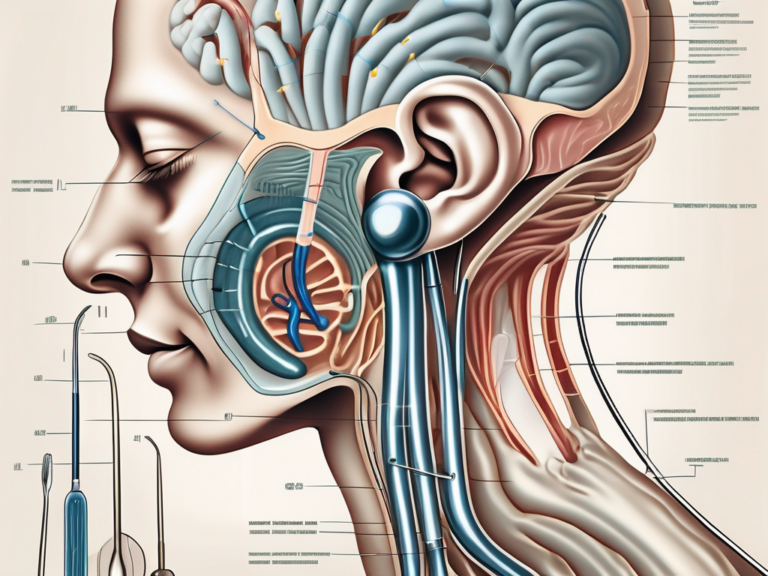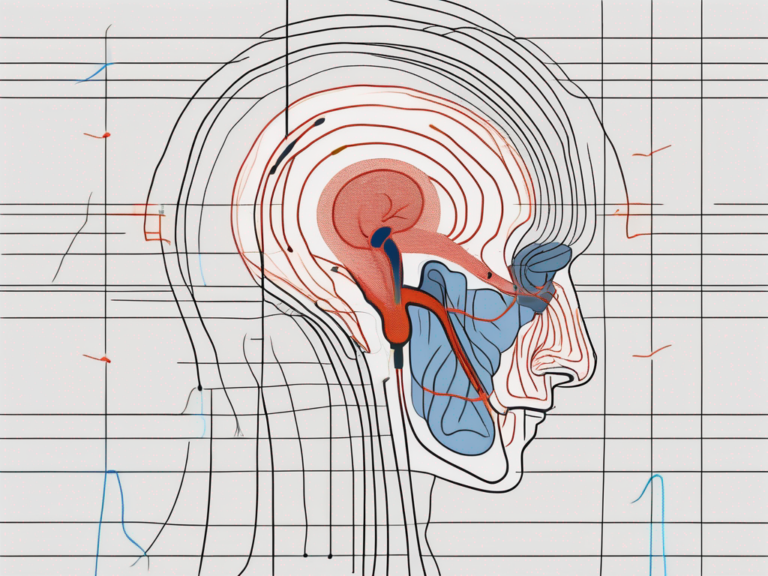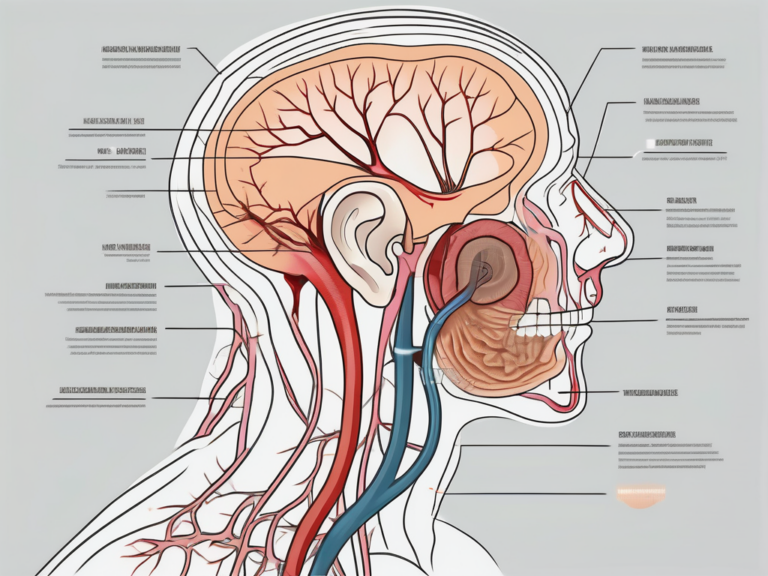The vestibular nerve is a critical component of the auditory and balance systems in the human body. It plays a crucial role in transmitting sensory information from the inner ear to the brain. Understanding the anatomy, function, and related disorders of the vestibular nerve can provide valuable insights into the complexities of human balance and hearing.
Understanding the Vestibular Nerve
At its core, the vestibular nerve is a branch of the eighth cranial nerve, also known as the vestibulocochlear nerve or the auditory-vestibular nerve. It is responsible for transmitting sensory information from the vestibular organs, semicircular canals, and utricle and saccule, to the brain. This information primarily pertains to the maintenance of balance and spatial orientation, closely interacting with the auditory system for hearing capabilities.
The vestibular nerve plays a crucial role in our daily lives, allowing us to navigate our surroundings with ease. Without this nerve, simple tasks such as walking, running, or even standing upright would be incredibly challenging. Let’s delve deeper into the anatomy and function of this remarkable nerve.
Anatomy of the Vestibular Nerve
The vestibular nerve originates in the inner ear and connects to the brainstem. It consists of two branches: the superior division and the inferior division. The superior division carries signals from the utricle and the superior semicircular canal, while the inferior division transmits signals from the saccule and the posterior and horizontal semicircular canals.
Imagine the vestibular nerve as a complex network of fibers, intricately woven to ensure the smooth transmission of vital information. These fibers travel through the internal auditory canal, a bony canal located in the temporal bone. Within this canal, the vestibular nerve shares space with the cochlear nerve, which is responsible for transmitting sound signals to the brain. Together, these cranial nerves work in harmony to maintain our sense of balance and hearing.
As the fibers of the vestibular nerve wind their way through the internal auditory canal, they form a connection between the inner ear and the brainstem. This connection allows for the swift and accurate transmission of sensory information, enabling us to respond to changes in our environment with precision.
Function of the Vestibular Nerve
The primary function of the vestibular nerve is to provide the brain with sensory information about head movements, positions, and spatial orientation. This information assists in maintaining proper balance, coordination, and equilibrium. Without the vestibular nerve, our ability to navigate the world around us would be severely compromised.
When we tilt our heads, spin around, or change our body positions, the vestibular nerve springs into action, relaying crucial data to the brain. This data allows the brain to make rapid adjustments to our posture and muscle activity, ensuring that we remain stable and upright.
Furthermore, the vestibular nerve collaborates closely with the cochlear nerve to support our hearing capabilities. By working in tandem, these nerves contribute to spatial auditory processing, allowing us to accurately perceive the location and direction of sounds in our environment.
In conclusion, the vestibular nerve is a remarkable component of our sensory system. Its intricate anatomy and vital function enable us to maintain balance, coordinate movements, and process auditory information effectively. The next time you take a step or turn your head, remember to thank your vestibular nerve for its tireless work in keeping you steady and aware of your surroundings.
The Pathway of the Vestibular Nerve
The vestibular nerve pathway begins in the labyrinth of the inner ear, which consists of the vestibular organs responsible for balance and the cochlea responsible for hearing. The labyrinth is a complex structure that plays a crucial role in our ability to maintain equilibrium and perceive spatial orientation.
The vestibular organs, including the utricle, saccule, and semicircular canals, are filled with fluid and lined with specialized sensory cells called hair cells. These hair cells are equipped with tiny hair-like projections called stereocilia, which are deflected by the movement of the fluid in response to head motion. This mechanical stimulation triggers the hair cells to generate electrical signals, which are then transmitted to the brain via the vestibular nerve.
Origin of the Vestibular Nerve
The vestibular nerve originates from the vestibular ganglion, a cluster of sensory neurons located within the inner ear. These ganglion cells play a crucial role in relaying sensory information from the vestibular organs to the brain. They receive signals from the vestibular hair cells in the utricle, saccule, and semicircular canals, converting mechanical vibrations into electrical signals for transmission to the brain.
Interestingly, the vestibular ganglion is not a single entity but rather a collection of individual ganglia, each associated with a specific vestibular organ. This organization allows for precise and segregated transmission of information from each organ to the brain, ensuring accurate perception of balance and spatial orientation.
Course of the Vestibular Nerve
After leaving the vestibular ganglion, the vestibular nerve fibers merge with the cochlear nerve fibers, forming the vestibulocochlear nerve. This combined nerve, also known as the eighth cranial nerve, is responsible for transmitting both auditory and vestibular information from the inner ear to the brain.
The vestibulocochlear nerve then passes through the internal auditory canal, a bony canal within the temporal bone. Along its journey, the nerve travels alongside other important cranial nerves, including the facial nerve and the nervus intermedius. This close proximity allows for the coordination and integration of sensory information related to both hearing and balance.
Within the brainstem, the fibers of the vestibular nerve project to various structures involved in balance and coordination. One important destination is the vestibular nuclei, which are located in the brainstem and receive input from the vestibular nerve. These nuclei play a crucial role in integrating vestibular information with other sensory inputs and coordinating motor responses to maintain balance.
In addition to the vestibular nuclei, the fibers of the vestibular nerve also project to other regions of the brain involved in balance control. These include the cerebellum, a structure known for its role in motor coordination, and the thalamus and cerebral cortex, which are responsible for higher-order processing and perception of sensory information.
Overall, the pathway of the vestibular nerve is a complex and highly organized system that allows for the transmission and integration of sensory information related to balance and spatial orientation. By understanding this pathway, we can gain insights into the intricate mechanisms that underlie our ability to maintain equilibrium and navigate the world around us.
Disorders Related to the Vestibular Nerve
Despite its crucial role in maintaining balance and hearing, the vestibular nerve is susceptible to various disorders that can significantly impact an individual’s quality of life. Vestibular nerve disorders often manifest as dizziness, vertigo, imbalance, and difficulties with spatial coordination.
The vestibular nerve, also known as the eighth cranial nerve or the vestibulocochlear nerve, is responsible for transmitting sensory information from the inner ear to the brain. This information helps the brain interpret head movements, maintain balance, and coordinate eye movements.
One of the most common vestibular nerve disorders is vestibular neuritis, which is caused by inflammation of the nerve. This inflammation can be triggered by viral infections, such as the common cold or flu. Vestibular neuritis can result in severe vertigo, accompanied by nausea and difficulty with balance.
Another disorder related to the vestibular nerve is Meniere’s disease, a chronic condition characterized by recurrent episodes of vertigo, hearing loss, tinnitus, and a feeling of fullness in the affected ear. The exact cause of Meniere’s disease is unknown, but it is believed to be related to fluid buildup in the inner ear, which disrupts the normal functioning of the vestibular nerve.
Symptoms of Vestibular Nerve Disorders
The symptoms of vestibular nerve disorders can vary widely depending on the specific condition and the extent of nerve damage. Some common symptoms include persistent vertigo, unsteadiness, nausea, ringing in the ears (tinnitus), hearing loss, and problems with concentration and memory.
Individuals with vestibular nerve disorders may experience a constant sensation of spinning or a feeling of being off-balance, even when they are standing still. This can greatly affect their ability to perform daily activities and may lead to anxiety and depression.
In addition to the physical symptoms, vestibular nerve disorders can also impact cognitive function. Many individuals with these disorders report difficulties with concentration, memory, and problem-solving. These cognitive impairments can further contribute to a decreased quality of life and may require additional support and accommodations.
It is important to note that experiencing these symptoms does not necessarily indicate a vestibular nerve disorder. Other conditions, such as migraines, inner ear infections, and certain medications, can also cause similar symptoms. It is essential to consult with a healthcare professional for an accurate diagnosis and appropriate treatment.
Diagnosis and Treatment of Vestibular Nerve Disorders
Diagnosing vestibular nerve disorders typically involves a comprehensive evaluation of the individual’s medical history, a detailed physical examination, and specialized tests such as vestibular function tests, audiometry, and imaging studies.
Vestibular function tests, such as electronystagmography (ENG) or videonystagmography (VNG), measure eye movements to assess the functioning of the vestibular system. These tests can help identify abnormalities in the vestibular nerve and determine the underlying cause of the symptoms.
Audiometry, which measures hearing sensitivity, is often performed to assess the extent of hearing loss associated with vestibular nerve disorders. Imaging studies, such as magnetic resonance imaging (MRI), may also be used to rule out other potential causes and to visualize the structures of the inner ear and brain.
Treatment options for vestibular nerve disorders are highly dependent on the specific condition and individual circumstances. They may include medications, vestibular rehabilitation exercises, lifestyle modifications, and surgical interventions. Management strategies aim to alleviate symptoms, enhance balance and spatial awareness, and improve overall quality of life.
Medications, such as anti-vertigo drugs and anti-nausea medications, can help alleviate the symptoms of vestibular nerve disorders. Vestibular rehabilitation exercises, which involve specific head and body movements, can help retrain the brain to compensate for the vestibular dysfunction and improve balance.
Lifestyle modifications, such as avoiding triggers that worsen symptoms (e.g., certain foods, alcohol, or caffeine) and implementing stress management techniques, can also be beneficial. In some cases, surgical interventions, such as decompression surgery or nerve sectioning, may be considered for individuals who do not respond to conservative treatments.
Living with a vestibular nerve disorder can be challenging, but with proper diagnosis and treatment, individuals can effectively manage their symptoms and regain control over their lives. Support from healthcare professionals, as well as from family and friends, is crucial in navigating the physical, emotional, and cognitive aspects of these disorders.
The Vestibular Nerve and Balance
The vestibular nerve plays a crucial role in maintaining balance, an intricate process that requires the coordination of sensory information from various systems within the body. By relaying information about head movements and positions, the vestibular nerve enables the brain to generate appropriate motor responses, ensuring stability and preventing falls.
But how exactly does the vestibular nerve accomplish this remarkable feat? Let’s take a closer look.
Role of the Vestibular Nerve in Maintaining Balance
Within the brainstem, the vestibular nerve fibers connect with the vestibular nuclei, which serve as vital centers for processing balance-related information. These nuclei receive sensory input from the vestibular organs, which include the utricle, saccule, and semicircular canals.
When you move your head, fluid inside these vestibular organs shifts, stimulating hair cells that line their walls. These hair cells convert the mechanical motion of the fluid into electrical signals, which are then transmitted through the vestibular nerve fibers to the vestibular nuclei.
Once the vestibular nuclei receive this information, they relay it to other parts of the brain involved in balance control, such as the cerebellum and the motor cortex. These intricate connections allow the brain to synchronize input from the vestibular nerve with information regarding vision, proprioception (sensory feedback from muscles and joints), and the motor system.
By integrating this information, the brain can generate motor commands that maintain stability and coordination, adapting the body to changes in position and environment. For example, if you tilt your head to the side, the vestibular nerve signals this change to the brain, which then adjusts the muscle activity in your neck, trunk, and legs to keep you upright.
Impact of Vestibular Nerve Damage on Balance
While the vestibular nerve is essential for maintaining balance, damage to this nerve can disrupt the intricate balance pathways, leading to various balance-related issues. Vestibular nerve disorders can be caused by a variety of factors, including viral infections, head trauma, and certain medications.
Individuals with vestibular nerve damage may experience difficulties with balance, unsteadiness, frequent falls, and an increased risk of accidents. These symptoms can significantly impact daily activities, negatively affecting mobility and overall quality of life.
If you suspect that you may be experiencing balance problems related to the vestibular nerve, it is essential to consult with a healthcare professional for a proper evaluation and guidance on appropriate management strategies. Treatment options may include vestibular rehabilitation exercises, medication, or in some cases, surgical intervention.
In conclusion, the vestibular nerve is a remarkable component of our sensory system that plays a vital role in maintaining balance. Its intricate connections with other parts of the brain allow us to adapt to changes in our environment and keep us steady on our feet. However, when this nerve is damaged, it can have a significant impact on our ability to maintain balance and navigate the world around us. Seeking professional help is crucial for managing vestibular nerve disorders and improving overall quality of life.
The Vestibular Nerve and Hearing
While the primary role of the vestibular nerve is to provide sensory information related to balance, it also plays a critical role in the auditory system. The close relationship between the vestibular nerve and the cochlear nerve allows for an intricate interaction between hearing and balance processes.
Connection Between the Vestibular Nerve and Hearing
The vestibular nerve fibers and the cochlear nerve fibers are closely intertwined within the internal auditory canal. This intimate connection enables communication between the vestibular and auditory systems, allowing for the coordination of hearing and balance functions.
Specifically, the vestibular nerve plays a role in maintaining the tonicity and amplitude of sound-induced oscillations within the cochlea. This regulation is crucial for the appropriate processing and interpretation of sound signals by the auditory system.
How Vestibular Nerve Disorders Affect Hearing
In some individuals with vestibular nerve disorders, hearing problems may accompany balance-related symptoms. The exact mechanisms of how vestibular nerve disorders affect hearing are complex and can vary depending on the specific condition.
Symptoms may include sensorineural hearing loss, tinnitus (ringing in the ears), or hyperacusis (sensitivity to loud sounds). These auditory manifestations can significantly impact an individual’s communication abilities, social interactions, and overall well-being.
If you are experiencing changes in your hearing or balance, it is crucial to seek medical evaluation to identify the underlying cause and discuss potential treatment options. A healthcare professional can guide you through appropriate diagnostic procedures and provide necessary support and management strategies tailored to your specific needs.
In conclusion, the vestibular nerve is a vital component of both the auditory and balance systems. Its intricate anatomy, essential functions, and relationship with various disorders highlight its significance in maintaining equilibrium and supporting hearing capabilities. Understanding the vestibular nerve and its role in the human body can assist both healthcare professionals and individuals in managing and addressing related concerns effectively. If you experience any symptoms or concerns related to the vestibular nerve, it is always advisable to consult with a medical professional for proper evaluation and guidance tailored to your specific circumstances. Health and well-being should always be prioritized, and seeking professional advice is an essential step in addressing any health-related concerns.







+ There are no comments
Add yours